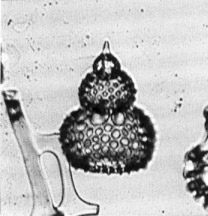 Eucyrtidium
diaphanes Sanfilippo and Riedel
Eucyrtidium
diaphanes Sanfilippo and Riedel Eucyrtidium
diaphanes Sanfilippo and Riedel
Eucyrtidium
diaphanes Sanfilippo and RiedelCalocyclas coronata Carnevale, 1908, p.33, pl.4, fig.24 (non Eucyrtidium coronatum Ehrenberg, 1873)
Eucyrtidium diaphanes Sanfilippo and Riedel in Sanfilippo et al., 1973, p.221, pl.5, figs.12-14 (new name)
Shell thick and with numerous ridges. The pores are circular, unequal, and arranged in lines transverse to the axis of the shell. The spine is moderately developed, conical and inclined to one side. The apex, thorax, and abdomen are separated from one another by the respective basal constrictions. At the top of the abdomen, along the re-entrant zone where it is attached to the thorax, there are 10 pores, which exceed all the others in size. The appendages are numerous acuminate, slightly developed, and arise at unequal intervals (translated from Carnevale, 1908).
Length of cephalis 19 µm; of thorax 44 µm; of abdomen 78 µm modified from Carnevale, 1908).
Shell of more than three segments, with a single row of large pores just below the lumbar stricture (Riedel and Sanfilippo, 1978a).
In addition, to the single row of large pores just below the lumbar stricture, the small, robust, subspherical thorax distinguishes this species from co-occurring members of the genera Eucyrtidium and Stichocorys.
Segments subsequent to the third are very variable in number and size - in some specimens wider and in others narrower than the third segment, sometimes only one additional, distally tapering segment is present. The size of the pores in the single row of large pores just below the lumbar stricture vary from 1 1/2 to 2 1/2 times the size of the abdominal pores. A similar row of larger pores may also be present just below the collar stricture in the proximal part of the thorax (Sanfilippo, unpubl. data).
This species is found in both low and middle latitudes of all oceans including the Mediterranean. Its morphotypic first appearance lies within the Cyrtocapsella tetrapera Zone and its morphotypic last appearance lies within the Calocycletta costata Zone.
Additional illustrations can be found in Riedel and Sanfilippo, 1978a, pl.5, fig.5.
See Sanfilippo et al., 1973, p.221 for discussion of new name.